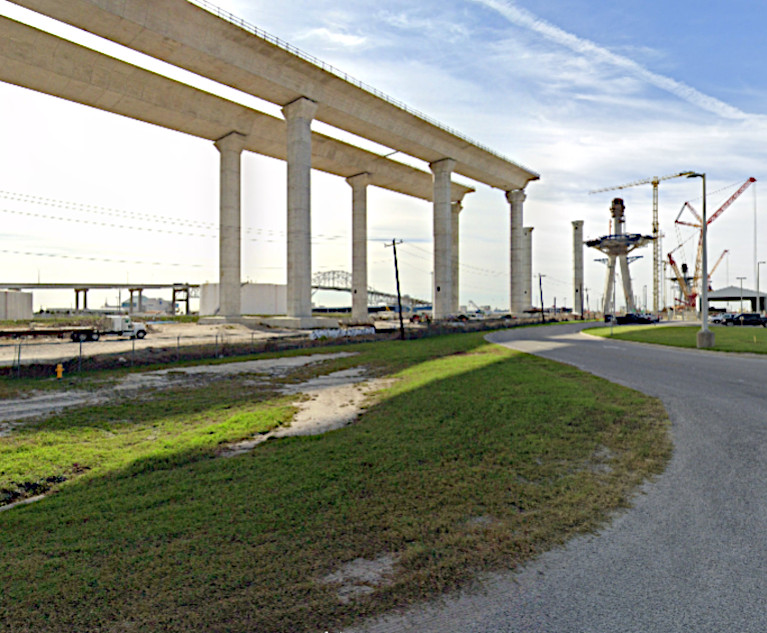Navigating Governmental Stay-at-Home Orders in Connection With Construction of Energy Projects
Though the DHS guidelines are just that—nonbinding guidelines for states to consider—they have impacted many states' stay‑at‑home orders and are of significant value to project owners in responding to such orders.
April 09, 2020 at 07:48 PM
5 minute read
 Kaleb Walker and Scott Greer of King & Spalding. (Courtesy photo)
Kaleb Walker and Scott Greer of King & Spalding. (Courtesy photo)
In the rapidly evolving landscape of COVID‑19 response, many states, counties and cities throughout the United States have taken drastic measures, including issuing executive orders halting all nonessential businesses. To provide direction on what businesses are essential, the U.S. Department of Homeland Security (DHS) has issued guidelines recommending that essential critical infrastructure workers (including construction workers in the energy industry) be allowed to continue working during the COVID‑19 response. Though the DHS guidelines are just that—nonbinding guidelines for states to consider—they have impacted many states' stay‑at‑home orders and are of significant value to project owners in responding to such orders.
DHS Guidelines
The DHS guidelines outline the critical infrastructure functions that the federal government deems "so vital to the United States that their incapacitation or destruction would have a debilitating effect on security, national economic security, national public health or safety, or any combination thereof." The DHS has grouped these critical infrastructure functions into 16 sectors, including, for example, health care and public health, transportation systems, critical manufacturing, and energy. With respect to the energy sector, the Cybersecurity and Infrastructure Security Agency of the DHS stated in its March 19 memorandum that workers who are "working construction" constitute "essential critical infrastructure workers."
Moreover, the guidelines break down the energy sector into subcategories of critical infrastructure, including the electricity industry, petroleum workers, and natural and propane gas workers. And, within each of these subcategories, the guidelines specifically list types of essential workers and their roles in the energy sector (e.g., workers who deal with generation of electric power or nuclear power, petroleum product storage, natural gas pipelines, LNG facilities, etc.). Thus, the DHS guidelines paint a detailed and helpful picture of the federal government's view on which activities are essential and thus should continue during the COVID‑19 response. Understanding this view may prove extremely valuable to owners faced with navigating a state's stay‑at‑home order affecting the construction or operation of their projects.
Responding to (or Preparing for) a Stay‑at‑Home Order
Some states have relied on the DHS guidelines when issuing stay‑at‑home orders, while other states have not done so. Because a state's own stay‑at‑home order ultimately governs over DHS guidelines, it is necessary for owners to carefully review the state's order in determining whether construction activity on a particular project may continue.
The most important step in reviewing a state's stay‑at‑home order is to determine the scope of the order's stay‑at‑home mandate and identify any exemptions (including whether the order cites the DHS guidelines in connection with any exemptions). If the order expressly adopts the DHS guidelines or otherwise exempts construction on energy projects, then construction on the project should be permitted to continue without further appeal to the governor (or other issuing authority).
Some state orders, however, may not adopt or reference the DHS guidelines, or may otherwise halt all business activities without exempting construction projects. One option for owners dealing with such an order is to write directly to the governor (or other issuing authority) and request clarification of the order's scope or an exemption from the order based on the DHS guidelines. This may be particularly effective if the project falls within one of the subcategories or lists expressly set out in the DHS guidelines (electric power, petroleum workers, LNG facilities, etc.).
Even if a state has not yet issued a stay‑at‑home order, owners should consider taking prompt and proactive steps to mitigate any potential impacts to the construction or operation of their projects. For example, an effective strategy may be to reach out to state and local representatives (including governors and attorney generals) to inform them of the DHS guidelines and which activities are deemed by the DHS as essential critical infrastructure functions. Another step would be to prepare proactive letters to such representatives to inform them that the construction or operation of the project is an essential critical infrastructure pursuant to DHS guidelines.
Preparation Is Key
In the interest of protecting and better managing their projects, owners should be familiar with the DHS guidelines. This familiarity should prove valuable in responding to stay-at-home orders or in laying the groundwork for such a response. Fortunately, in many states, simply being prepared may be enough because the majority of states have followed the DHS guidelines when issuing stay‑at‑home orders, allowing construction of energy projects to continue. For example, the governors of the states of California, Connecticut and Louisiana recently cited the DHS guidelines to exempt from such orders construction workers on critical infrastructure so they can continue performing their work on such critical infrastructure projects. Other state orders, while not specifically referencing the DHS guidelines, have allowed construction on certain energy infrastructure to continue. However, other states, such as Pennsylvania, issued an executive order seemingly prohibiting all construction related activities with minor exceptions, which has since then been clarified. In today's rapidly evolving environment of COVID‑19, owners would be well-served to develop a plan for handling even the most restrictive stay-at-home orders.
Scott Greer, a partner in the Houston office of King & Spalding, focuses exclusively on construction law and leads the firm's worldwide energy and construction transactional practices. A licensed professional engineer, he represents owners and developers in a wide range of projects throughout the U.S. and the world. He can be reached at [email protected].
Kaleb Walker is an associate in the firm's Houston office, and represents owners and developers in their on-shore and off-shore construction projects throughout the U.S. and the world. He can be reached at [email protected].
This content has been archived. It is available through our partners, LexisNexis® and Bloomberg Law.
To view this content, please continue to their sites.
Not a Lexis Subscriber?
Subscribe Now
Not a Bloomberg Law Subscriber?
Subscribe Now
NOT FOR REPRINT
© 2025 ALM Global, LLC, All Rights Reserved. Request academic re-use from www.copyright.com. All other uses, submit a request to [email protected]. For more information visit Asset & Logo Licensing.
You Might Like
View All
Jury Awards $2M Damages, Attorney Fees, Enforcing Oral Partnership Agreement
4 minute read


Holland & Knight Launches Mexican Construction Practice to Advise Nearshoring Clients
Law Firms Mentioned
Trending Stories
- 1Lavish 'Lies' Led to Investors Being Fleeced in Nine-Figure International Crypto Scam
- 2AstraZeneca Files Flurry of Lawsuits to Protect Cancer Treatment Drug
- 3American Airlines Legal Chief Departs for Warner Bros. Discovery
- 4New Montgomery Bar President Aims to Boost Lawyer Referral Service
- 5Deadline Extended for Southeastern Legal Awards
Who Got The Work
Michael G. Bongiorno, Andrew Scott Dulberg and Elizabeth E. Driscoll from Wilmer Cutler Pickering Hale and Dorr have stepped in to represent Symbotic Inc., an A.I.-enabled technology platform that focuses on increasing supply chain efficiency, and other defendants in a pending shareholder derivative lawsuit. The case, filed Oct. 2 in Massachusetts District Court by the Brown Law Firm on behalf of Stephen Austen, accuses certain officers and directors of misleading investors in regard to Symbotic's potential for margin growth by failing to disclose that the company was not equipped to timely deploy its systems or manage expenses through project delays. The case, assigned to U.S. District Judge Nathaniel M. Gorton, is 1:24-cv-12522, Austen v. Cohen et al.
Who Got The Work
Edmund Polubinski and Marie Killmond of Davis Polk & Wardwell have entered appearances for data platform software development company MongoDB and other defendants in a pending shareholder derivative lawsuit. The action, filed Oct. 7 in New York Southern District Court by the Brown Law Firm, accuses the company's directors and/or officers of falsely expressing confidence in the company’s restructuring of its sales incentive plan and downplaying the severity of decreases in its upfront commitments. The case is 1:24-cv-07594, Roy v. Ittycheria et al.
Who Got The Work
Amy O. Bruchs and Kurt F. Ellison of Michael Best & Friedrich have entered appearances for Epic Systems Corp. in a pending employment discrimination lawsuit. The suit was filed Sept. 7 in Wisconsin Western District Court by Levine Eisberner LLC and Siri & Glimstad on behalf of a project manager who claims that he was wrongfully terminated after applying for a religious exemption to the defendant's COVID-19 vaccine mandate. The case, assigned to U.S. Magistrate Judge Anita Marie Boor, is 3:24-cv-00630, Secker, Nathan v. Epic Systems Corporation.
Who Got The Work
David X. Sullivan, Thomas J. Finn and Gregory A. Hall from McCarter & English have entered appearances for Sunrun Installation Services in a pending civil rights lawsuit. The complaint was filed Sept. 4 in Connecticut District Court by attorney Robert M. Berke on behalf of former employee George Edward Steins, who was arrested and charged with employing an unregistered home improvement salesperson. The complaint alleges that had Sunrun informed the Connecticut Department of Consumer Protection that the plaintiff's employment had ended in 2017 and that he no longer held Sunrun's home improvement contractor license, he would not have been hit with charges, which were dismissed in May 2024. The case, assigned to U.S. District Judge Jeffrey A. Meyer, is 3:24-cv-01423, Steins v. Sunrun, Inc. et al.
Who Got The Work
Greenberg Traurig shareholder Joshua L. Raskin has entered an appearance for boohoo.com UK Ltd. in a pending patent infringement lawsuit. The suit, filed Sept. 3 in Texas Eastern District Court by Rozier Hardt McDonough on behalf of Alto Dynamics, asserts five patents related to an online shopping platform. The case, assigned to U.S. District Judge Rodney Gilstrap, is 2:24-cv-00719, Alto Dynamics, LLC v. boohoo.com UK Limited.
Featured Firms
Law Offices of Gary Martin Hays & Associates, P.C.
(470) 294-1674
Law Offices of Mark E. Salomone
(857) 444-6468
Smith & Hassler
(713) 739-1250






